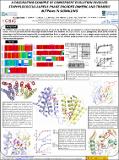Por favor, use este identificador para citar o enlazar a este item:
http://hdl.handle.net/10261/181496COMPARTIR / EXPORTAR:
 SHARE
BASE SHARE
BASE
|
|
| Visualizar otros formatos: MARC | Dublin Core | RDF | ORE | MODS | METS | DIDL | DATACITE | |

| Título: | A fascinating example of convergent evolution involves Staphylococcus aureus phage encoded dimeric and trimeric dUTPases in signaling |
Autor: | Ciges-Tomas, J. Rafael CSIC ORCID; Donderis, Jorge CSIC; Maiques, Elisa CSIC ORCID; Bowring, Janine Z.; Neamah, Maan M.; Alite, Christian CSIC ORCID; Tormo-Mas, M.A.; Penadés, José R. CSIC ORCID; Marina, Alberto CSIC ORCID | Fecha de publicación: | 23-oct-2017 | Editor: | Sociedad Española de Bioquímica y Biología Molecular | Citación: | XL SEBBM Congress (2017) | Resumen: | The dUTPase (Dut) enzymes prevent the misincorporation of uracil into the DNA and are encoded by almost all free-living organisms and some viruses. We have previously showed that phage-encoded trimeric Duts mediates the Staphylococcus aureus pathogenicity island (SaPIs) transfer by interacting to the SaPI-encoded repressor Stl, proposing that these Duts are regulatory proteins. Some S. aureus phages encode structurally unrelated dimeric Duts instead trimeric Duts. Surprisingly, a recent work, has involved one of these predicted dimeric Duts in the transfer of SaPIs by interacting with the same Stl repressor. With the aim of decipher the molecular basis of SaPI induction by dimeric Duts and to compare with the mechanism reported for trimeric Duts, we examined the SaPI mobilization capacity of dimeric Duts in vivo as well as its binding capacity to Stl repressor in vitro. We analyzed the effect of the dUTP in the Stl-Dut interaction, and finally, we solved the 3-D structure by X-ray crystallography of several dimeric Duts in different activation states. Our results show that dimeric and trimeric Duts from S. aureus phages present a striking parallelism in the mechanism of SaPI mobilization. These similarities would confirm the role of dUTP as new nucleotide with second messenger function. However, some differences suggest peculiarities in the molecular mechanism of Stl recognition and binding for each type of Duts. Our results support the idea that the signalling role of the Dut proteins is an important force driving evolution and speciation. | Descripción: | Póster presentado al XL SEBBM Congress. Barcelona, 23-26 de octubre de 2017 | URI: | http://hdl.handle.net/10261/181496 |
| Aparece en las colecciones: | (IBV) Comunicaciones congresos |
Ficheros en este ítem:
| Fichero | Descripción | Tamaño | Formato | |
|---|---|---|---|---|
| Poster_Rafa SEBBM 2017.pdf | 12,72 MB | Adobe PDF |  Visualizar/Abrir |
CORE Recommender
Page view(s)
283
checked on 23-abr-2024
Download(s)
115
checked on 23-abr-2024
Google ScholarTM
Check
NOTA: Los ítems de Digital.CSIC están protegidos por copyright, con todos los derechos reservados, a menos que se indique lo contrario.
